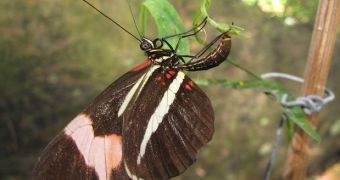A new investigation proposes a daring explanation for the wide variety of patterns and wing colors present in the world's butterflies. Researchers say that the insects experienced such an evolution in their ability to see, that regular colors no longer seemed to cut it when it came to mate selection. This was especially true in the case of butterflies that had evolved colors that resembled the ones of their less-good-tasting relatives. This self-defense mechanism also proved to be detrimental to the survival of the species, in the sense that many individuals found it hard to select the proper mate amidst the confusion.
But, now, experts say that new discovery hints at a hidden selection mechanism. A study has revealed that, in the case of the Heliconius butterflies, the insects are able to recognize ultraviolet light. In this species, some individuals are born with a duplicate gene that allows them to see UV colors. But the team has also learned that the same individuals also feature a certain amount of yellow UV pigment on their wings, which in turn helps them recognize their own kind. Being able to spot members of their own species via this method leaves the creatures more time to eat, reproduce, and generally thrive.
“We think that by switching to a new way of making yellow, the mimetic butterfly species were better able to tell each other apart,” University of California in Irvine (UCI) researcher Seth Briscoe says. He adds that he and his team is convinced the butterflies first started displaying this mutation some 12 to 25 million years ago, but explains that more research is needed in order to establish the exact time when this happened. The scientists add that only this species, of the 14,000 types of known butterflies, has the UV pigment and the duplicated gene. The creatures live in the forests of Mexico, and in the wide swaths of South America.
This is the latest work in a string of researches that aim to clear some of the mysteries associated with animal camouflage. Other investigations have analyzed spiders, and their ability to blend with their environment, but this study is the first to look at the genetic base of mate selection abilities in butterflies. Full details of the investigation appear in the latest online issue of the respected journal Proceedings of the National Academy of Sciences (PNAS), LiveScience reports.

 14 DAY TRIAL //
14 DAY TRIAL //